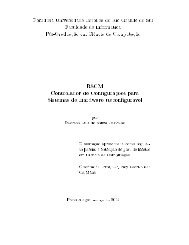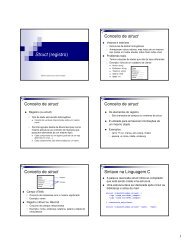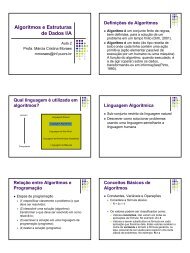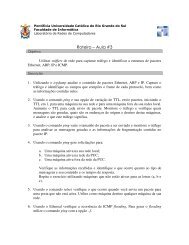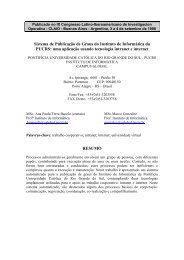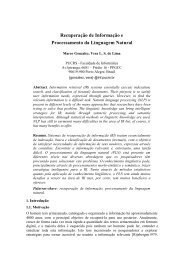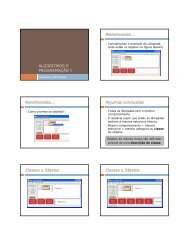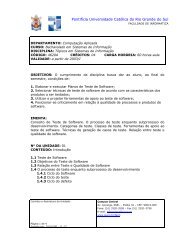Introdução à Linguagem C - pucrs
Introdução à Linguagem C - pucrs
Introdução à Linguagem C - pucrs
You also want an ePaper? Increase the reach of your titles
YUMPU automatically turns print PDFs into web optimized ePapers that Google loves.
<strong>Introdução</strong> <strong>à</strong> <strong>Linguagem</strong> C<br />
Estrutura de um Programa em C<br />
• Cabeçalho: bibliotecas, variáveis globais,<br />
declaração de rotinas.<br />
• Bloco de Instruções Principal e Bloco de<br />
Rotinas<br />
Profª. Leticia Lopes Leite<br />
Laboratório de Programação A<br />
• Documentação do Programa (comentários)<br />
Profª. Leticia L. Leite - lleite@inf.<strong>pucrs</strong>.br<br />
Características da <strong>Linguagem</strong> C<br />
• Estruturada:<br />
• formada por blocos por funções<br />
• a execução do programa começa sempre<br />
pela função main.<br />
• a linguagem C faz distinção entre<br />
maiúsculas e minúsculas.<br />
Exemplo<br />
#include <br />
void main ( )<br />
{<br />
printf (“Olá”);<br />
}<br />
Profª. Leticia L. Leite - lleite@inf.<strong>pucrs</strong>.br<br />
Profª. Leticia L. Leite - lleite@inf.<strong>pucrs</strong>.br<br />
Cabeçalho<br />
• Bibliotecas:<br />
• <br />
• <br />
• <br />
• <br />
• <br />
O processo de Compilação em C<br />
• Existem comandos que são processados<br />
durante a compilação do programa<br />
(diretivas de compilação) . Estes comandos<br />
informam ao compilador do C quais são as<br />
constantes usadas no programa e quais<br />
bibliotecas devem ser anexadas ao<br />
programa executável.<br />
Profª. Leticia L. Leite - lleite@inf.<strong>pucrs</strong>.br<br />
Profª. Leticia L. Leite - lleite@inf.<strong>pucrs</strong>.br
Para o compilador...<br />
Lembrem-se ...<br />
void main ( )<br />
{<br />
}<br />
void main ( ) { }<br />
A função main ( ) deve existir em<br />
algum lugar do programa, pois é a<br />
partir dela que o programa começará<br />
a ser executado.<br />
São programas idênticos<br />
Profª. Leticia L. Leite - lleite@inf.<strong>pucrs</strong>.br<br />
Profª. Leticia L. Leite - lleite@inf.<strong>pucrs</strong>.br<br />
Dados<br />
Constantes<br />
Variáveis<br />
Variáveis<br />
• Espaço de memória reservado para armazenar um<br />
certo tipo de dado tendo um nome para referenciar o<br />
seu conteúdo.<br />
• Não apresenta valor fixo.<br />
• Nome pode ter até 32 caracteres, começando com<br />
letras ou sublinhado, seguidos de letras, números ou<br />
sublinhados.<br />
• Não podem ter nome igual ao de palavras reservadas<br />
da linguagem.<br />
Profª. Leticia L. Leite - lleite@inf.<strong>pucrs</strong>.br<br />
Profª. Leticia L. Leite - lleite@inf.<strong>pucrs</strong>.br<br />
Palavras Reservadas<br />
asm auto break case cdecl char<br />
class const continue _cs default delete<br />
do double _ds else enum _es<br />
extern _export far _fastcall float for<br />
friend goto huge if inline int<br />
interrupt _loadds long near new operator<br />
pascal private protected public register return<br />
_saveregs _seg short signed sizeof _ss<br />
static struct switch template this typedef<br />
union unsigned virtual void volatile while<br />
Constantes<br />
• Apresenta um valor fixo e inalterável.<br />
• Tem um tipo de dado associado.<br />
Profª. Leticia L. Leite - lleite@inf.<strong>pucrs</strong>.br<br />
Profª. Leticia L. Leite - lleite@inf.<strong>pucrs</strong>.br
Tipos de Dados<br />
• A divisão se deve basicamente ao<br />
número de bytes reservados para cada<br />
dado.<br />
• Cada tipo de dado possui um intervalo<br />
de valores permitidos.<br />
Tipos Básicos de Dados<br />
• Inteiro <strong>à</strong> int<br />
• Real (ponto flutuante) <strong>à</strong> float<br />
• Caracter <strong>à</strong> char<br />
• Seqüência de caracteres <strong>à</strong> string<br />
Profª. Leticia L. Leite - lleite@inf.<strong>pucrs</strong>.br<br />
Profª. Leticia L. Leite - lleite@inf.<strong>pucrs</strong>.br<br />
Representação dos Tipos Básicos<br />
de Dados<br />
• Integer <strong>à</strong> %d<br />
• Float <strong>à</strong> %f<br />
• Char <strong>à</strong> %c<br />
Observação 1:<br />
• Separador decimal para números em<br />
ponto flutuante é o ponto final ( . ).<br />
• Também pode ser escrito em notação<br />
científica.<br />
Profª. Leticia L. Leite - lleite@inf.<strong>pucrs</strong>.br<br />
Profª. Leticia L. Leite - lleite@inf.<strong>pucrs</strong>.br<br />
Observação 2:<br />
Tipos de Dados x Memória<br />
• Os caracteres são representados entre aspas<br />
simples ( ´ ).<br />
Tipo<br />
Bytes<br />
Escala<br />
• Exemplos:<br />
Char<br />
1<br />
-128 a 127<br />
´Mariana´<br />
´Elvira´<br />
S<br />
t<br />
r<br />
i<br />
n<br />
g<br />
´M´<br />
´A´<br />
c<br />
h<br />
a<br />
r<br />
Int<br />
Float<br />
Double<br />
2<br />
4<br />
8<br />
-32.768 a 32.767<br />
3.4e -38 a 3.4e +38<br />
1.7e -308 a 1.7e +308<br />
Profª. Leticia L. Leite - lleite@inf.<strong>pucrs</strong>.br<br />
Profª. Leticia L. Leite - lleite@inf.<strong>pucrs</strong>.br
Operadores Aritméticos<br />
Exemplos<br />
Operação<br />
Adição<br />
Subtração<br />
Multiplicação<br />
Divisão<br />
Operador<br />
+<br />
-<br />
*<br />
/<br />
• 1+45<br />
• 45-38<br />
• 24*8<br />
• 12.5/3<br />
Profª. Leticia L. Leite - lleite@inf.<strong>pucrs</strong>.br<br />
Profª. Leticia L. Leite - lleite@inf.<strong>pucrs</strong>.br<br />
Operadores Aritméticos<br />
Exemplos<br />
Operação<br />
Resto da Divisão<br />
Inteira<br />
Potenciação<br />
Raiz Quadrada<br />
Absoluto<br />
Somente para<br />
Operador operadores<br />
inteiros<br />
%<br />
pow<br />
sqrt<br />
abs<br />
• 4%3 <strong>à</strong> 1<br />
• pow(4,2) <strong>à</strong> 16<br />
• sqrt (36) <strong>à</strong> 6<br />
• abs (-1234) <strong>à</strong> 1234<br />
Profª. Leticia L. Leite - lleite@inf.<strong>pucrs</strong>.br<br />
Profª. Leticia L. Leite - lleite@inf.<strong>pucrs</strong>.br<br />
Operadores Relacionais<br />
Operadores Relacionais<br />
Operação<br />
Operador<br />
Operação<br />
Operador<br />
Igual a<br />
==<br />
Menor ou igual<br />
<br />
Incremento<br />
++<br />
Maior ou igual<br />
>=<br />
Menor<br />
<<br />
Profª. Leticia L. Leite - lleite@inf.<strong>pucrs</strong>.br<br />
As instruções com operadores relacionais retornam<br />
0 para Falso e 1 para Verdadeiro.<br />
Profª. Leticia L. Leite - lleite@inf.<strong>pucrs</strong>.br
Precedência de Operadores<br />
• Avaliação da esquerda para direita.<br />
• Mudança na precedência: uso de parênteses<br />
• Semelhante a matemática:<br />
-- ++<br />
* /<br />
Mais alta<br />
Exemplos<br />
• 4 == 4<br />
• 5 != 4<br />
• 5 > 4<br />
• 4 >= 4<br />
• 3 < 7<br />
• 3
Declaração de Variáveis<br />
• Informa ao processador quais são os<br />
nomes utilizados para armazenar dados<br />
de variáveis e quais tipos são utilizados.<br />
• Exemplo:<br />
char a;<br />
float media;<br />
int z, k, m;<br />
Profª. Leticia L. Leite - lleite@inf.<strong>pucrs</strong>.br<br />
Separador para<br />
variáveis de um<br />
mesmo tipo - vírgula<br />
Declaração de variáveis<br />
• Normalmente é feita dentro de uma rotina.<br />
• Exemplo:<br />
void main ( )<br />
{<br />
int k, z,j;<br />
char a;<br />
. . .<br />
}<br />
Profª. Leticia L. Leite - lleite@inf.<strong>pucrs</strong>.br



